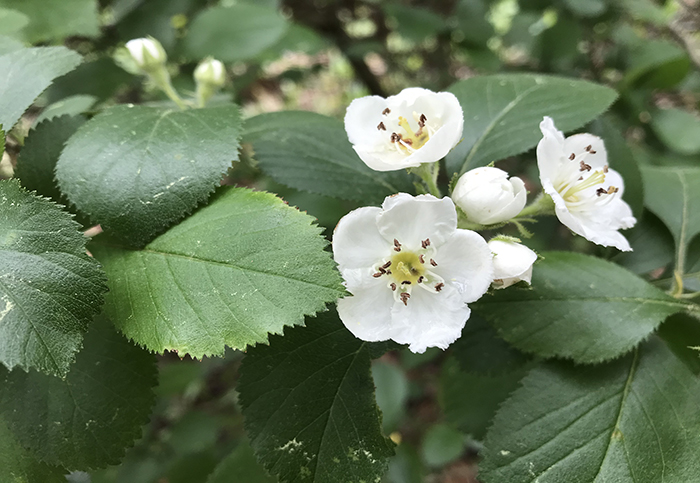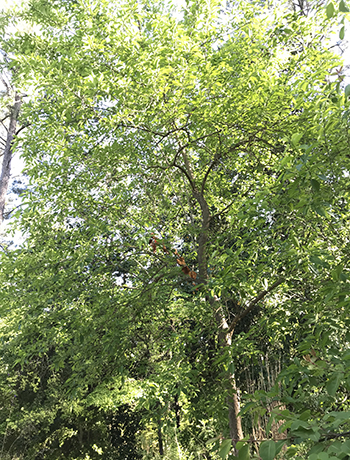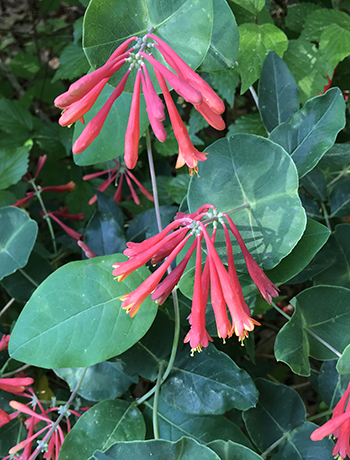Garden Talk

A ROLE FOR THE HUMBLE HEDGEROW IN THE 21ST CENTURY

By Annabel Renwick
Curator, Blomquist Garden of Native Plants
Raised in England, where hedgerows are integral to the landscape, I’m intrigued by the growing advocacy for the reintroduction of hedges in the United States for wildlife. I say "re"introduction, as during the 19th and the early part of the 20th centuries, hedgerows were a sizable component of the landscape in many parts of the rural Midwest and eastern regions of North America.
Nowadays, hedges that surround gardens mostly contain evergreen shrubs such as yew, holly or English laurel planted for privacy or as a green foil to showier plants. But living fences, as they are frequently called in the U.S., are more than a design element. Not only do they provide homes and give protection to many wild animals, birds and insects, but they also create wildlife corridors; bats, for instance, are known to use hedgerows as navigational guides. Farmers have long recognized the value of hedges as shelterbelts—they protect grazing animals in the depths of winter and also reduce water erosion of soil and wind damage to crops. Just as important to the natural world is their role as the countryside’s "pantry," supplying nectar, pollen, nuts and fruits to both wildlife and the human population.
Growing up in rural northeastern England, I collected bright red rosehips from the wild dog-rose briars (Rosa canina) that scrambled through the hedges around my grandfather’s farm. These "hips" were sent to a local food processing company, where a sweet-tasting rosehip syrup packed with vitamin C was produced specifically for infants. In return, we gatherers received a few pennies for each pound of rosehips we supplied. Another ‘"free" food from the hedgerow was the simple blackberry (Rubus fruticosus), which I would gather with my young children during late September. After a few hours of picking fruit and enjoying a ramble along a country lane, I would discover there would be just enough berries in the basket to make a pie that would disappear faster than the purple-red stains on my boys’ fingers and around their mouths; of course they had been eating the berries as fast as they were being picked! Even the autumn half term holiday from school used to be called "Blackberry Picking Week," as it coincided with the ripening of the blackberries.
Blackberries and rosehips are just two examples of the rich harvest that is produced in the English hedgerow. Additional bounty includes the damsons (Prunus domestica); the sloe-berry, or fruit from a wild plum known as blackthorn (Prunus spinosa), used to make the liqueur sloe gin; wild cherries (Prunus avium); hazelnuts (Corylus avellana); elderberries (Sambucus nigra); and crab apples (Malus sylvestris). Much of this wild food was traditionally made into jams, jellies and even wines. Many of these European species were brought to the United States by the early settlers, and some have naturalized in the northern, cooler states.
If the hedgerow produce can be of such nutritious value to the human population, consider its worth to the native wildlife—not only in the fall with the rich fruits and nuts, but also in spring with the pollen and nectar for insects. What follows is a brief overview of the history and ecology of a traditional British hedgerow, a highlight of the very short period in U.S. history when hedges were in fashion, followed by an open question: Can hedges native to the Southeast be established on a wide scale to provide homes and refuges for native wildlife in this region?

History of the Hedgerow
Anyone with the opportunity to travel to England will find a distinctive and unmistakable landscape, a patchwork quilt of fields bounded by hedges. Hedgerows were not grown so that grandma could have fruit to make pies, but to mark property and divide fields. They formed the boundaries of church parishes, manorial estates, individual fields and private gardens.
Some of the earliest and simplest fences were built to separate grazing animals from food crops and were made from bundles of brush held in place with poles and stakes. Native shrubs, briars and wildflowers would grow from seeds trapped in the woody structure, creating a living shrubbery along field edges. Farmers could augment the "dead" hedge by adding young tree saplings or directly sowing the seeds of native shrubs nearby to create a thicker, thornier boundary. It is conceivable that many ancient hedgerows—defined as being more than 300 years old and existing before the enclosure of common land that took place between 17th and 19th centuries—started out life as one of these diverse fencerows. Conversely, the hedges planted after this time were dominated by the common hawthorn (Crataegus monogyna), propagated by specialized growers that sprang up throughout England.
The reason for this transition was political and cultural. During a 200- year period beginning in the 17th century, the passage of more than 4,000 "Enclosure Acts" led to the abolition of the traditional open field system and the privatization of common land, almost 7 million acres in total. Not only did these changes result in the checkered landscape seen today, they destroyed the livelihood of the rural poor who had previously used the common land for grazing or cropping. They were now forced to find work in the cities or emigrate to far-flung places such as America. Although tens of thousands of miles of hedgerows have been removed due to modern agricultural practices, approximately 250,000 miles of rural hedges remain throughout Britain.
Hedgerow Ecology
Devon, a county in southwest England with an area half the size of the Triangle in N.C., has around 33,000 miles of hedgerows. Ecological studies have shown that some of these ancient Devonshire hedges support more than 2,000 different species of native flora and fauna. There are regional variations in the structure of hedges, but a hedge is usually grown along the top of a raised bank, with a ditch often on both sides. In Devon, the raised bank can reach 5 to 6 feet in height. Its sides are faced with stone, and the shrubs are planted across the top of the bank. It is the very nature of this hedge-bank, with its various nooks and crannies, that makes Devonshire hedgerows so species-rich, possessing lots of diverse niches for various creatures and plant life to inhabit.

Native English hedgerows are dominated by common hawthorn and blackthorn, both members of the rose family that send out clusters of white flowers in the spring. The blackthorn, which flowers a month earlier, is particularly important for native bumblebees and other early pollinators, especially when food is scarce. The hedgerows can be colonized by various vines and briars, such as the native honeysuckle (Lonicera periclymenum), old man’s beard (Clematis vitalba) and English ivy (Hedera helix), as well as the wild dog-rose and blackberry. The honeysuckle, with its tubular flowers, is pollinated by long-tongued native bumblebees, and the flowers of English ivy are a late October favorite (though the species itself is an exotic invasive when transplanted to North Carolina). Successful pollination of the hedgerow flowers in the spring is critical for the formation of autumn fruits, which supply food for birds and mammals during the long winter months.
The English landscape has been heavily molded by human activities for the past millennium. Although artificial in origin, the venerable hedgerow has itself become an ecosystem. In regions of extensive agriculture, these living boundaries may be the only place many native flora and fauna can find refuge.
The Hedgerow in the United States
As the European colonists settled in North America, their priorities were simple: defining property boundaries and producing food. Due to the abundance of trees, wood was the obvious choice for fencing. Yet by the end of the 18th century, forests were depleted and wood became scarce throughout the eastern states. Wood is versatile, and it was also used for the construction of homes, furniture, farming tools and fencing, and as firewood. By the start of the 19th century, quality hardwood suitable for fencing was scarce, and consequently very expensive. Fencing a farm became a substantial burden to the landowner, in which the cost of the material could be more expensive than the land itself. Farmers looked for alternatives, including stone walls and hedges.
Many English emigres moved to Delaware and Pennsylvania during the late 18th and early 19th centuries and brought with them the skills needed for hedge-laying and maintenance, especially hawthorn hedges. The English common hawthorn did not adapt well to the mid-Atlantic climate, with its dry, hot summers, so this species was replaced with native hawthorns. A frequent favorite was the cockspur hawthorn (Crataegus crus-galli), bearing very long, sharp thorns like its avian namesake. Although highly attractive when in full bloom, cockspur hawthorn is relatively slow growing and requires four to six years to establish a sound hedge. This hawthorn hedge was expensive to install, and its continued maintenance needed skilled laborers. Common farmers could rarely afford to grow hawthorn hedges, let alone pay for the expertise to maintain them, and so these hedges tended to adorn the homesteads of the wealthier gentleman farmers.
As the Midwestern states were being settled and the prairies turned into homesteads, the scarcity of trees for wooden fencing was acute. Early settlers of this region would use sod or earthen walls with ditches as one of the cheapest means to keep animals out of their field crops. Stone fences were also built where stone was available, particularly in Kansas. Here, hedgerows were a welcome solution, though they took a very different form from their eastern counterparts.

Osage-orange (Maclura pomifera), a heavily thorned tree native to Texas, Arkansas and Oklahoma, became the species of choice for hedgerows throughout the Midwest. The dense, hard wood is slow to rot and was highly valued by the Native Americans, who used it to make many tools including bows, leading to its French name, bois d'arc.
Maclura pomifera is fast growing, taking only two to three years for newly planted shrubs to grow into a hedge that would be "horse high, bull strong and hog tight." During the mid- to late 19th century, millions of Osage-orange plants were propagated by regional nurseries and tens of thousands of miles of hedgerows planted, creating a major industry throughout the Midwest, peaking during the "hedge mania" of the 1860s. However, the love affair with the Osage-orange hedge waned when barbed wire was invented in the mid-1860s, becoming the cheaper alternative for fencing, especially as the western states were settled. Farmers, being practical and canny with their resources, repurposed the Osage-orange hedges and used the wood for fence posts, though many hedges remained. In 1895, there were close to 50,000 miles of hedging in Kansas alone, and even as late as 1939, the USDA measured 39,400 miles of Osage hedge fencing there. Today Osage-orange trees are still found outside their native range, and their presence may signal the remains of an old homestead or a living fence that once may have separated a farmer's fields.
Following World War II, agriculture intensified in the pursuit of efficient crop production, and many miles of hedges were removed, as fields expanded to accommodate larger farm machinery both in the U.S. and U.K. Wildlife declined as a result of modern farming techniques, and by the mid-1960s the value of hedgerows for wildlife was once again being recognized. A 1965 USDA farmers bulletin, "Making Land Produce Useful Wildlife," recommended multiflora roses (Rosa multiflora) and autumn olive (Elaeagnus umbellata) hedges for wildlife cover, arguing that these plants were easy to grow, looked attractive and supplied food for wildlife. The authors even commented on the fact that these plants were not liked by all farmers, as they would encroach onto farmland. Fifty-five years later, these two species are reviled as exotic invasives. Although the choice of hedging material was a mistake, the sentiment to create hedges for wildlife was laudable. Instead of introducing exotic plants into the rural landscape, regional, native plants should have been advocated.
The hedgerow, native or exotic, is not a panacea. The transition from extensive native prairie into intensive farmland forever altered the ecology of this grassland biosystem. The Osage-orange hedging was implicit in the demise of the prairie and its wildlife, including the greater prairie chicken (Tympanuchus cupido), a ground nesting bird that had ironically found protection from predators in its branches.
The Blomquist Garden Native Hedge

England is the size of North Carolina and has a population of 56 million people, and its agriculture is intensive, yet native wildlife has adapted to man-made hedges. These living fences are essential in helping to maintain the flora and fauna diversity of the British Isles.
Hedges are an opportunity for landowners, whether urban or rural, to create habitats for native wildlife. Here in the Blomquist Garden of Native Plants at Sarah P. Duke Gardens, we are planting a native hedge made from a mixture of Southeastern native shrubs and wildflowers. This region has an extraordinary range of plants that can be used for hedging, and our plant selection has been determined by the location of the new hedge, at the top of a free draining bank in full sun. Our mixture includes the hop-hornbeam (Ostrya virginiana), which is drought tolerant and already growing on the bank, and whose fruit is an important food source for many birds. The Carolina cherry-laurel (Prunus caroliniana), an evergreen shrub offering winter cover for birds, small mammals and overwintering insects, is drought tolerant and actively colonizing the dry bank as well. It is also the host plant for a range of caterpillars of native butterflies, including the coral hairstreak, eastern tiger swallowtail and viceroy butterflies. Fruits of the Carolina cherry-laurel are eaten by a variety of songbirds and small wild animals.
One of my favorite plants in the Blomquist is the American plum (Prunus americana). I look forward to seeing this harbinger of spring when it blooms in late February/early March, and taking in the delicate perfume of the rose-like flowers. The ripened plums in the fall attract various wild animals. As with the Carolina cherry-laurel, the underground runners of this species will help stabilize the bank. The yellow catkins dangling from the bare branches of the American hazel (Corylus americanus) in late winter are a warming sight. The increasingly rare Luna moth caterpillars (Actias luna) graze the leaves of this valuable wildlife plant. In late summer, hazelnuts form on the trees, but you have to be quick to protect these nuts from squirrels if you want to eat them yourself.

We will add the local Washington hawthorn (Crataegus phaenopyrum) to the mix, which produces white rose-like flowers during spring feeding the bee, wasp and fly populations; the fruit is eaten by birds and various small mammals throughout the winter. To these major shrubs we will add a sprinkling of arrowroot (Viburnum dentatum), red chokeberry (Photinia pyrifolia) and the high bush blueberry (Vaccinium corymbosum), as well as the wild native rose (Rosa carolina) and native honeysuckle (Lonicera sempervirens), all supplying a variety of flower forms in the spring and fruit during late summer or fall. We expect this native, mixed-species hedge to take a few years to establish, and we will monitor the growth and adaptability of the various species to the site and their allure to wildlife. We plan to share our experience of creating this hedge at Duke Gardens, so stay tuned!
Please note: Duke Gardens is closed until further notice, including both indoor and outdoor areas, in keeping with Duke University’s COVID-19 health and safety policies. Our on-site horticulture staff are sharing photos, videos and information about the Gardens’ plant collections in the meantime, through Garden Talk and social media. We hope you like these features, and we look forward to enjoying the Gardens together once again in the future.
References
Managing hedges for the benefit of pollinators, Campaign for the Farmed Environment.
Hedges in history (2020)
Hedges, The Conservation Volunteers
C. Miller (2003). The Age of Wood
The Atlas of the U.S. and Canada: Environmental History
C. Van Ravenswaay (1970) "America’s Age of Wood". American Antiquarian Society, pp. 47-56
Clarence H. Danhof (1944). "The fencing problem of the eighteen fifties." Agricultural History, Vol.18: 168-186
Wallace L. Anderson and Felix Summers (1965). Making Land Produce Useful Wildlife: Fencerows and hedges. USDA Bulletin Issue 2035
Larry Rutter (2001). Osage-orange partly built environments. Kansas Historical Society
Lesley Hewes (1982). "Early Fencing on Western Margin of the Prairie." Nebraska History 63:301-348
Paul G. Bourcier (1984). "'In excellent order' The Gentleman Farmer Views His Fences, 1790 – 1860." Agricultural History 58:546-5
Mississippi Department of Conservation. Enduring Osage-orange (1995)
Scott Vogt (2015). Osage-orange: A historical living fence.

Photos from top: Hawthorn flowers in the Blomquist; formal English garden with evergreen hedge border; semi-wild English hedgerow along a country road in Buckinghamshire; Osage orange in the Blomquist; fruit of the American plum; coral honeysuckle flowers; future site of the Blomquist native hedge along Flowers Drive (plant photos by Annabel Renwick; portrait by Rick Fisher).





